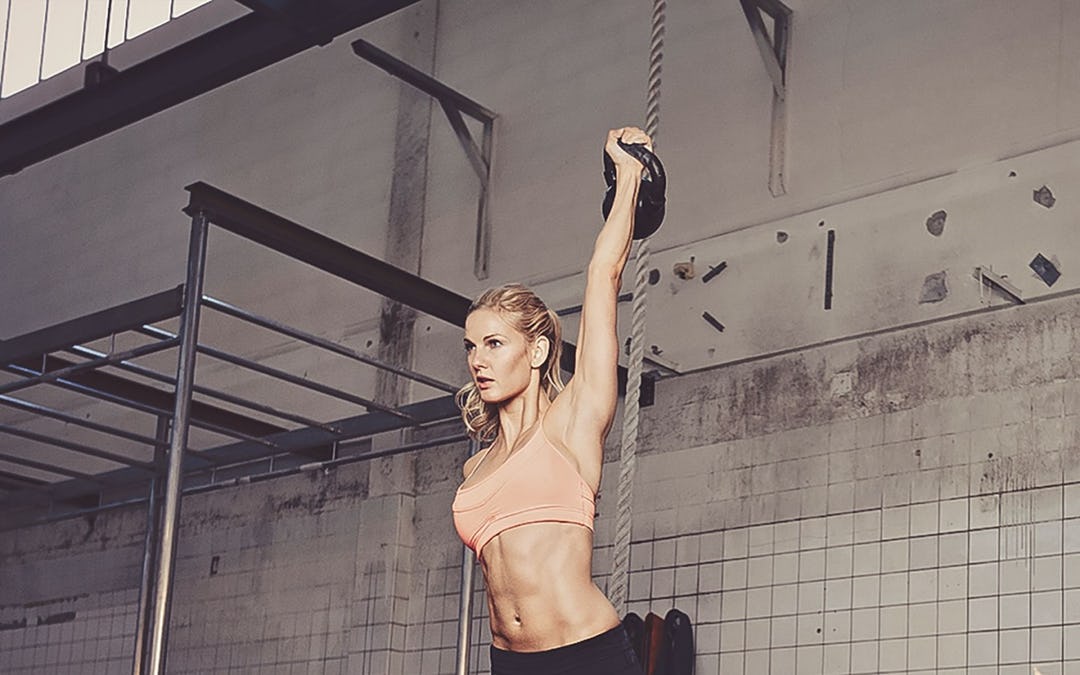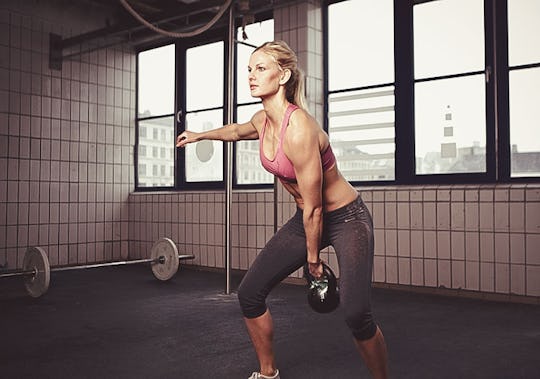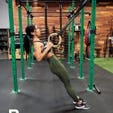The kettlebell swing is widely regarded as the king of all kettlebell exercises. It trains the commonly weak posterior chain muscles (glutes, hamstrings) like no other exercise, and it strengthens the core. It’s hard to argue with the swing’s standing…
But as good as the swing is as a kettlebell exercise, I believe the snatch actually surpasses it. Let’s call it, the Mother of All Kettlebell Exercises—even the king. The snatch is a beautiful, explosive movement that gets the posterior chain firing and core engaged, and it helps to stabilize the shoulder. It increases your heart rate, engages the whole body, and trains up your weaknesses.
How To Do A Kettlebell Snatch
Step 1: Stand with feet between hip and shoulder-width apart, holding a kettlebell in your right hand at shoulder level. The handle should rest diagonally in your hand just above your thumb—not near your fingers.
Step 2: With your shoulders drawn back and downward (think: proud chest), press the bell straight overhead, locking out your elbow. This is the finish position of the snatch, and if you can’t get into it properly, it’s an indication that you shouldn’t be snatching yet. Your ribs should be down, core braced, and pelvis level to the floor.
Step 3: Lower the weight back to the rack position, where the bell is shoulder level and your forearm is vertical.
Step 4: Now bend your forearm inward toward the midline of your body while simultaneously extending your elbow. Gravity will take over and pull the bell toward the floor—control its descent. When the bell lowers to just in front of your thighs, hinge at the hips, bending them back and hiking the bell between your legs. Maintain a long spine, keeping your head and pelvis aligned. Core still braced. Maintain your proud chest position as the bell hikes back, so that your shoulders are square to the floor.
Step 5: When your hips are fully bent, extend them explosively to stand tall again. As you rise, pull your elbow straight up vertically and, when it can’t rise anymore, allow the momentum from your hips to help you punch your fist straight to the ceiling. The bell should wrap around your wrist as your elbow extends. You shouldn’t need your fingers to finish the lift.
If you time it right, the kettlebell won’t smash into the back of your forearm.
When first learning the snatch, begin every rep from the arm extended position, lowering the weight down into the rack position and then hip hinging as described above. As you get comfortable with the movement, you can begin the snatch from the rack position, and then by simply hiking it from the floor (as shown in the video above).
Muscles Used During The Kettlebell Snatch
– Glutes
– Quads
– Hamstrings
– Core
– Upper back
– Shoulders
– Grip
The Keys To A Great Snatch
The kettlebell swing is, of course, integral within the snatch. The snatch is simply a progression of the single-arm kettlebell swing. You must be able to do a proficient swing before advancing to the snatch.
The hip hinge is the foundation of the snatch and should be the driving force. A ragged and inefficient snatch can usually be traced back to a deficient swing. While you will no doubt incorporate your grip and shoulder muscles, you do not want these to be the primary movers. The power in the snatch comes from the hips.

Beyond the posterior chain conditioning, the snatch is a brilliant exercise for the shoulder girdle. You need to quickly decelerate and stabilize the kettlebell. This is incredible for building strength and stability.
As mentioned in the directions above, if you have an unstable or misaligned overhead lockout position, then you are not ready to embrace the snatch. The overhead position is foremost as the bell spends the majority of its time there. This is particularly the case with longer-lasting sets that we see in kettlebell sport competitions.
Holding the bell overhead helps you develop shoulder stability. The bell shouldn’t be drifting in different directions when it’s overhead. This is why, in addition to the swing, the overhead press and overhead walk are pre-requisites to performing the snatch. You also want to ensure that your overhead lockout position is aligned properly. You can see how it should be aligned in the picture below.
The arm is vertical with an extended elbow and neutral wrist. The arm runs through the middle of the torso and the middle of the hip.
Benefits of the Kettlebell Snatch![The Mother of All Kettlebell Exercises…The Kettlebell Snatch]()
The snatch works the glutes and hamstrings hard. These muscles extend the hips, and are responsible for generating the power and quickness you need in virtually all sports. The snatch also works the shoulder girdle. While you don’t press the weight overhead to finish the movement, flinging it up with the power of your hips and then having to “catch” the bell and decelerate its upward trajectory forces your stabilizer muscles to clamp down hard. This builds stability in the shoulder joints, which is needed for any pressing or pushing you do, in the gym or out.
As a matter of fact, the kettlebell snatch can be a great alternative to the overhead press if you are having shoulder issues. It helps create more thoracic mobility—the ability to extend your upper back (stand tall). This takes pressure off your shoulder joints. The movement also bypasses the AC joint, so if you have pain due to impingement in this area, the one-arm snatch shouldn’t aggravate it.
Much like the kettlebell swing, the kettlebell snatch is a magnificent movement for developing your aerobic capacity. It is a good alternative to traditional aerobic activities because there is no impact on the joints, as there is with running and jumping rope. Nevertheless, the metabolic response is impressive to say the least.
The snatch incorporates more muscles than the swing. Therefore, it is superior when it comes to the metabolic impact. A recent study examined 17 female NCAA Division 1 soccer players who undertook a snatch program for 4 weeks. The increase in VO2 max was significant and far superior to traditional circuit training.
Kettlebell Snatch Exercises To Try
The following snatch variations all have their place in a workout program. Experiment with the following and see how they can serve your goals.
One-Arm Deadstart Snatch Kettlebell Exercise
Starting the snatch from the floor will build incredible upper-body pulling strength and core stability. This variation may also be safer for your lower back because you don’t generate as much momentum on the way down. However, it requires you to own the deadlift position, picking the bell up off the floor, and that means a greater range of motion. So it’s a slightly more advanced move than the classic one-arm snatch.
Step 1: Place a kettlebell on the floor directly under your hips.
Step 2: Get your shoulders in a proud chest position and hinge your hips to grasp the kettlebell with your right hand. Your wrist should be slightly flexed.
Step 3: Explosively extend your hips and pull the kettlebell up, keeping it close to your body.
Step 4: As it passes head level, allow the kettlebell to rotate around the forearm as you punch through at the top.
Step 5: Lower the kettlebell slowly to the rack position.
Step 6: Unravel the kettlebell back to the ground and repeat.
Tips and Safety: Avoid rounding your back in order to pick up the kettlebell. Maintain a long spine and tension throughout the movement to keep your back safe. Utilize a loose grip to avoid ripping your hands or calluses. Keep the kettlebell close to the body throughout the entire movement.
Half-Kneeling One-Arm Kettlebell Snatch Exercise
If the basic snatch is too challenging, regress to this version, which allows you to focus on the hip action and punch-through more safely.
Step 1: Get into a half-kneeling position with your left knee on the ground.
Step 2: Place a kettlebell under your hips.
Step 3: Pack your shoulders into the proud chest position and hinge your hips to grasp the kettlebell with your left hand, wrist slightly flexed.
Step 4: Explosively pull the kettlebell up, keeping it close to your body.
Step 5: As it passes head level, allow the kettlebell to rotate around the forearm as you punch through at the top.
Step 6: Lower the kettlebell slowly to the rack position.
Step 7: Unravel the kettlebell back to the ground and repeat.
Tips and Safety: Avoid rounding your back in order to pick up the kettlebell. Maintain a long spine and tension throughout the movement to keep your back safe. Utilize a loose grip to avoid ripping your hands or calluses. Keep the kettlebell close to the body throughout the entire movement.
Kettlebell One-Arm Rotational Snatch Exercise
This snatch variation is excellent for building rotational power as well as shoulder strength and flexibility. Make sure you can perform the basic snatch and have mastered the punch-through before attempting this movement.
Step 1: Bring a light bell to the rack position on the right side.
Step 2: Internally rotate, and then swing the bell across your body to the outside of your right shoulder.
Step 3: Pull up explosively, and punch through at the top while facing 90 degrees to the right.
Step 3: Rotate back to where your shoulders and hips are square, rack the weight, and repeat.
Tips and Safety: Exhale at the point of exertion and maintain a long spine throughout the movement. Keep a slightly loose grip to avoid tearing your hands or calluses. Make sure the weight does not jerk you down as it crosses the body. This means unraveling the bell and straightening your arm quickly to allow the swing across the body to be smooth. Maintain a long spine throughout the movement to avoid rounding or over-twisting.
Double Kettlebell Snatch Exercise
The double snatch builds tremendous upper-body pulling strength as well as core and posterior chain power. Make sure you have perfected the single arm snatch variations before attempting the double snatch to keep yourself safe. The benefits of the double snatch will carry over into all athletic endeavors.
Step 1: Set up a pair of kettlebells about a foot in front of you.
Step 2: With a shoulder-width stance, hinge and grasp the kettlebells while keeping a straight back.
Step 3: Explosively hike the kettlebells.
Step 4: Snap your hips and drive the kettlebells forward. As they start to pass your legs pull up hard while keeping the bells close to your body.
Step 5: As the bells pass your chest, start rotating so that the kettlebells will be put into position to punch through at the top.
Step 6: Unravel the kettlebells into a downswing, slightly further out in front of you than on the way up.
Step 7: Hike and repeat.
Tips and Safety: Exhale at the point of exertion and maintain a long spine throughout the movement. Keep a slightly loose grip to avoid tearing your hands or calluses. If you cannot safely unravel the bells, lower the bells down to the rack and unravel from there, as described in the basic snatch directions. This will allow you to work the double snatch without having to worry about dropping the kettlebells from overhead.



)





